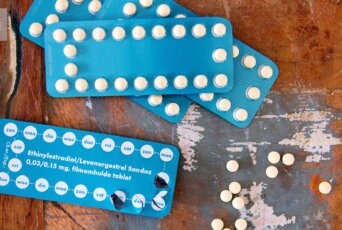One morning, Britt Martin was working with spreadsheets at her finance job; by evening, the healthy 25-year-old had been diagnosed with cancer and told she’d need to begin chemo as soon as possible. The craziest part? This is only the beginning of her healing journey. The chemo caused her to lose her period, and she became determined to find a natural treatment for amenorrhea, eventually discovering the practice known as seed cycling, or seed syncing. Read on to learn Britt’s story, as well as how seed cycling works, the link between flaxseed and estrogen, and why she founded her company, Food Period.
*This is a short clip from our interview with Britt Martin. Click here to watch the whole thing.*
You can also listen to an audio version of this interview on The WellBe Podcast.
A Cancer Diagnosis Out of Nowhere
Britt was in her mid-20s, living in Vancouver and working at a high-pressure finance job that she took very seriously. It was nearing the end of the calendar year, and she wanted to take advantage of her employer-provided massage benefits before they expired. She took the only appointment she could get: on Christmas Eve, with a massage therapist she’d never seen before.
Britt asked the massage therapist to work on her shoulders and clavicle, where she’d been experiencing tension. Shortly after the session had begun, the massage therapist stopped and asked Britt if she’d noticed the lump on her neck. She hadn’t. The massage therapist guided Britt’s hands to where the lump was, and she could feel that it was the size of a tennis ball. “I was pretty shocked to have not noticed something like that,” she said. The massage therapist told Britt that she would need to go see a doctor before she could do any more work on her.
A bit rattled, Britt called her doctor, but given that it was Christmas Eve, he wasn’t available. She brushed it off, deciding that she’d deal with it in the new year, and headed to her parents’ house. When she arrived, she showed the lump to her mom, an RN, who was making Christmas Eve dinner. Her mom immediately turned off the stove, put everything down, grabbed Britt’s hand, and told her they were going to the emergency room.
Six hours later, after an ultrasound and CT scan, the doctor told her that there was a 90% chance she had Hodgkin’s lymphoma, a type of blood cancer. A few days later, the diagnosis was confirmed. Less than three weeks after that, Britt began chemo.
Thankfully, the chemo worked and Britt is now cancer-free. But it also had an unexpected side effect: amenorrhea, or the loss of a menstrual cycle.
Looking for a Natural Treatment For Amenorrhea
About halfway through chemo, Britt stopped getting her period completely. She’d been what she describes as a “good patient” through the whole process, but she knew that this issue needed to be addressed.
“I brought my amenorrhea to my doctor and I said, ‘I’m not getting my period. It’s completely stopped,’” Britt remembers. “He said to me, ‘Don’t even worry. It’s fine. When we’re finished with chemo, we’re just going to put you on birth control pills to reinstate your cycle.” Her jaw dropped to the floor.
Britt wasn’t just appalled because of the dismissive and superficial nature of this response — she also had a history with the pill that made his recommendation even more inappropriate. She’d first gone on the pill at age 12 when her first period lasted for 21 days and doctors didn’t know how else to stop it. At 19, she’d been put on it again after being diagnosed with PCOS.
All of her experiences with the pill had been negative. “It completely affected my mood, I gained weight, and I had a lot of extreme experiences having taken the pill,” she says. “So the idea of putting more hormones and synthetic chemicals into my body after just completing six months of chemo — it seemed crazy to me.”
The entire cancer experience had been so unexpected and felt out of her control, so Britt knew that she needed to take this issue into her own hands and find a natural treatment for amenorrhea. “I decided that I was going to get my period back in a natural way. I’m not going to use birth control for that purpose,” she remembers.
From there, she went on a quest to find a natural treatment for amenorrhea, visiting and interviewing over a dozen natural health practitioners. She saw acupuncturists, naturopaths, three nutritionists, a functional medicine doctor, and more, asking them all what they did to support women’s menstrual health and treat amenorrhea naturally. It was in these interviews that she first heard about seed cycling.
Using Seed Cycling to Reverse Amenorrhea
Several of the practitioners Britt met with told her about seed cycling, or seed syncing, as a potential method for balancing her hormones and reversing her amenorrhea. We’ll go into the specifics of how seed cycling works below, but the basic gist is that you eat certain ground-up seeds at certain phases in your menstrual cycle.
When Britt heard about this method, she figured she might as well give it a try. “I thought, okay this seems harmless. It’s probably the most natural I can get. Let me just try it,” she says.
The practitioners she’d spoken with told her to give it three months before she expected results. So for three months, Britt scooped up her designated seeds, ground them up, and ate them, either in smoothies or salads or the little energy balls that she’d make. Three months to the day after she began seed cycling, her period returned.
What’s more, when Britt’s period came back, it was different than it had been before: it was much better. Previously, she’d always had difficult periods, with mood swings, painful cramps, and heavy flow. But this time, she had none of those symptoms. “I thought, ‘This is awfully strange. This is actually an enjoyable period,’” she says. “I was so shocked to not be in pain or discomfort or feeling a million different emotions at once, and just feeling super level.”
Some time afterward, Britt moved to New York and fell off with her seed cycling. Sourcing and grinding all the specific seeds was a time-consuming task, and her period had been so regular for a while that she figured she could stop. Soon after, her period went away again.
Of course, she’d had a positive experience with seed cycling on the first go-round — but she was still mildly skeptical that such a natural treatment could really work so well. So she decided to conduct a little experiment, changing absolutely nothing about her lifestyle and habits except for resuming seed cycling. Sure enough, two months later, her period came back.
Britt was sold on the effectiveness of seed cycling as a natural treatment for amenorrhea and other hormonal issues. She wondered whether other women might have had the same experience as her: finding success with seed cycling, then giving it up because it became too time-consuming. This notion sparked her to found Food Period, a company that makes functional food products (like the seed energy bites she’d been making for herself) that support women at every stage of their menstrual cycle.
How Seed Cycling Works and the Link Between Flaxseed and Estrogen
During a regular, healthy menstrual cycle, your hormone levels shift depending on what phase you’re in. During the first phase (called the follicular phase) which begins on the first day of your period, estrogen is produced as eggs and ovaries ripen. Once ovulation occurs, at the halfway point of the cycle, estrogen levels drop. Then, during the second phase (called the luteal phase), estrogen and progesterone steadily rise. Seed cycling is meant to restore or support these natural hormone shifts in women who have hormone imbalances.
There are four seeds involved in seed cycling: flaxseeds and pumpkin seeds for the follicular phase, then sesame and sunflower for the luteal phase. In practice, this means that each day for the first 14 days of your cycle (so, beginning when you get your period), you would take one tablespoon each of raw, freshly ground, organic flaxseed and pumpkin seeds. Then after ovulation, or after 14 days, you would switch to one tablespoon of each of raw, freshly ground, organic sesame and sunflower seeds. When you next get your period (or 14 days later if you don’t get a regular period), start the cycle over.
Each of the four seeds has certain micronutrients that are meant to support healthy hormones during each phase of your cycle. By consuming regular amounts on a regular basis, Britt says, “You’re just kind of training your body to kind of be in this rhythm.”
The main micronutrients are:
- Flaxseeds: Flaxseeds and estrogen have a powerful relationship. Flax has a high concentration of lignans, compounds that are converted into phytoestrogens when consumed. Phytoestrogens are plant-based compounds that can either mimic or hinder estrogen. Here, they help support the production and subsequent elimination of estrogen. As Britt explains, the lignans “bind to estrogen receptors and help the body’s elimination of excess estrogen, which is a big problem in the western world.”
- Pumpkin seeds: Pumpkin seeds contain zinc, which is said to promote the production of progesterone in preparation for the luteal cycle.
- Sesame seeds: Sesame seeds also have high levels of lignans, which here help to inhibit estrogen levels to keep them in check.
- Sunflower seeds: Sunflower seeds have a high vitamin E content, which is said to boost progesterone levels.
Britt explained that it’s important for the seeds to be ground because that makes their micronutrients more bioavailable, and that it’s important for them to be raw because heat can kill some of the micronutrients.
Currently, there’s not very much research to support the science behind or effectiveness of seed cycling, a fact that Britt attributes largely to its lack of economic potential. “You can’t patent seed syncing as a process. You can’t patent a recipe around an energy bite,” she says. “There’s not an economic impetus to study it and so, because pharmaceutical companies lead almost all of these major scientific studies, there is no research in-depth. So, a lot of the research ends up being anecdotal.”
Still, there is science out there that supports the idea behind seed cycling. Britt points to flax as the most studied seed, mainly because the relationship between flaxseed and estrogen has been studied with relation to menopause and perimenopause. In this research, ingesting flaxseeds has been shown to improve cycle regularity and hormone levels, as well as reduce hormone-related symptoms like hot flashes and mood changes.
Until more direct research exists on seed cycling, Britt and her team have taken it upon themselves to review the scientific literature related to each seed and its micronutrients, and cross-reference those studies with studies that focus specifically on the menstrual cycle. This way, by understanding what’s happening hormonally during each part of the cycle, they can layer on their understanding of the micronutrients and see the ways in which the seeds impact hormone levels. Looking at it from this angle, “it makes complete logical sense,” says Britt.
The WellBe Takeaway On Seed Cycling
Today, Britt has had a regular, symptom-free period for four years, and she said that she is proud that FoodPeriod has helped other women achieve the same thing. If you’re interested in trying seed cycling yourself, here’s what to remember:
- During a healthy menstrual cycle, your body’s levels of estrogen and progesterone shift depending on which phase you’re in. Seed cycling involves eating certain seeds at certain times during your cycle to support these shifts.
- The four seeds used in seed cycling are flaxseed, pumpkin seed, sunflower seeds, and sesame seeds. Flaxseed and pumpkin seeds are taken during the first 14 days, and sunflower and pumpkin seeds are taken during the second 14 days.
- Each of the designated seeds has certain micronutrients that help support the production or elimination of vital hormones.
- Lignans are one of the primary micronutrients at work in seed cycling. These compounds become phytoestrogens once ingested, which can then either mimic or hinder estrogen production.
- To try seed cycling, you need to take one tablespoon each of the designated seeds every day. The seeds must be raw, organic, and freshly ground.
Have you ever tried seed cycling? What was your experience? Tell us in the comments below.
Watch our full interview with Britt Martin to learn more about the role acceptance played in her path to healing, the connection between a painful period and stress, what her doctor told her PCOS meant for her ability to have children, how industry impacts the research and awareness around seed cycling, what seed cycling can help with besides amenorrhea, and more.
You can also listen to an audio version of this interview on The WellBe Podcast.
Citations:
- Rietjens, I. et al. The potential health effects of dietary phytoestrogens. Br J Pharmacol. 2017 Jun; 174(11): 1263–1280.
- Phipps, W. et al. Effect of Flax Seed Ingestion on the Menstrual Cycle. J Clin Endocrinol Metab. 1993 Nov;77(5):1215-9.
- Sammartino, A. et al. Short-term Effects of a Combination of Isoflavones, Lignans and Cimicifuga Racemosa on Climacteric-Related Symptoms in Postmenopausal Women: A Double-Blind, Randomized, Placebo-Controlled Trial. Gynecol Endocrinol. 2006 Nov;22(11):646-50.
The recovery story above is anecdotal and specific to this particular individual. Please note that this is not medical advice, and that not all treatments and approaches mentioned will work for everyone.







COMMENTS